30th July 2002 : Plimoth Plantation, North to Maine
After breakfast in the hotel, the plan was a visit to Plimoth Plantation and then drive North to Portland, Maine. On our way out of Plymouth, we went back to the very attractive "Jenny Pond", the mill pond for the original Grist Mill. We drove past on the Duck Tour on the previous day, and the setting and the wildlife looked to be worth another look.
Located where Town Brook meets Spring Lane, Jenny Pond is home to the gristmill that played an important role in the development of the Pilgrim society. The pond itself, is named after John Jenney who built the Pilgrims first gristmill on the site in 1636. The original mill was destroyed in 1847 by fire. A replica, built in 1970, stands in its place where corn is still being ground in the same way that it was over 350 years ago.
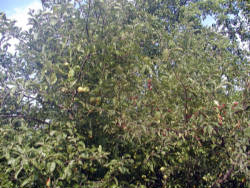
The Jenny Pond - Tree with two kinds of apples
|
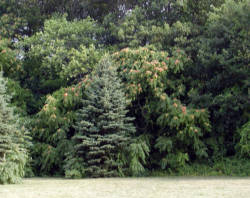
Trees near the Jenny Pond
|

The Jenny Pond
|
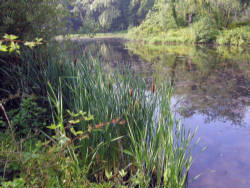
The Jenny Pond
|

The Jenny Pond
|
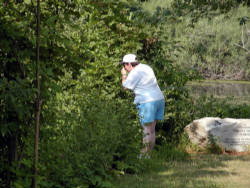
Sue taking photos of ducks on the Jenny Pond
|
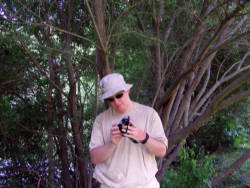
Chris at the Jenny Pond
|
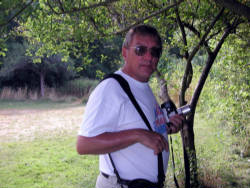
Mike at the Jenny Pond
|
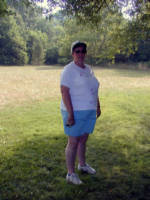
Sue at the Jenny Pond
|
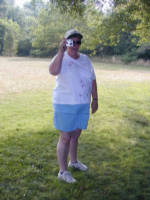
Sue at the Jenny Pond
|
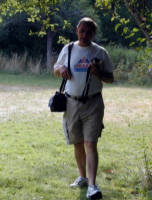
Mike at the Jenny Pond
|
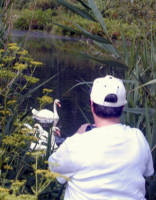
Sue at the Jenny Pond
|
|

Sue & Mike at the Jenny Pond
|
The Jenny Pond provides a home for a wide variety of water birds. The gray heron that we saw from the Duck Tour was nowhere to be seen, but there were plenty of ducks, geese and swans.
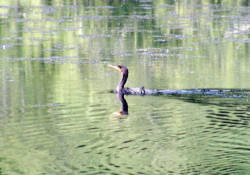
Black bird in the Jenny Pond
|
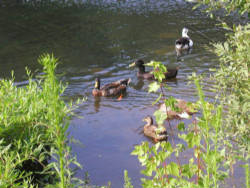
Ducks on the Jenny Pond
|
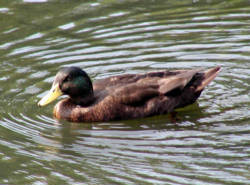
Duck on the Jenny Pond
|
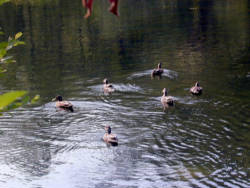
Ducks on the Jenny Pond
|
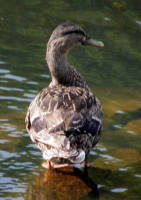
Duck on the Jenny Pond
|
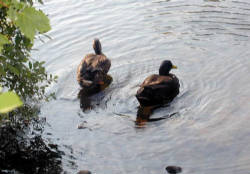
Ducks on the Jenny Pond
|
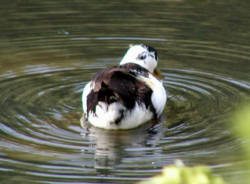
Duck on the Jenny Pond
|
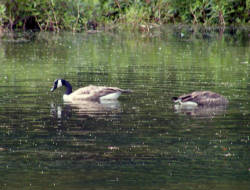
Ducks on the Jenny Pond
|
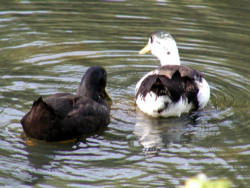
Ducks on the Jenny Pond
|
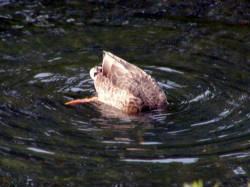
Duck on the Jenny Pond
|
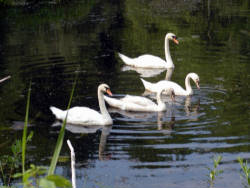
Swans on the Jenny Pond
|

Swans on the Jenny Pond
|
Plimoth (Plymouth) Plantation was the first permanent European settlement in southern New England (AD 1620). Today, this area is the site of a living museum, dedicated to recreating 17th century life ways in the New World.
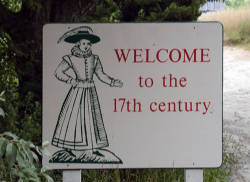
"Welcome to the 17th Century"
|
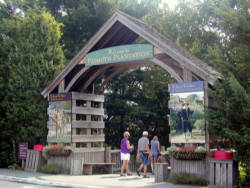
The Entrance
|
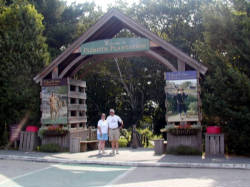
Mike & Sue at The Entrance
|
|
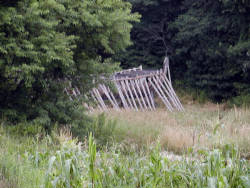
Building a boat in traditional manner
|
The Fort/Meetinghouse dominates the hillside on which the village is located. It is a timber-framed blockhouse, with a ground floor meeting area and an upper gun deck looking over the plantation towards the sea.
The wooden palisade, which encloses the village and the Fort/Meetinghouse, was built in 1662 on hearing news of the massacre of colonists in Virginia. Fortunately, attack never came, and the Fort/Meetinghouse was used as a meeting place for religious services and as a courthouse for the colony’s legislative and judicial affairs.
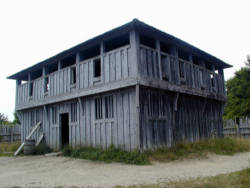
The Fort/Meeting House
|
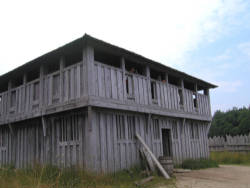
The Fort/Meeting House
|

The Fort/Meeting House
|
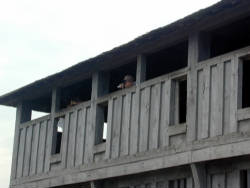
The Fort/Meeting House
|
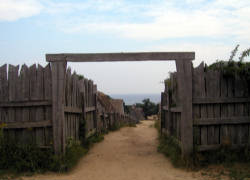
The entrance to the Village
|
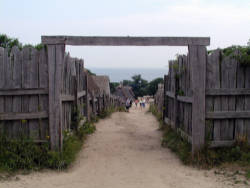
The entrance to the Village
|
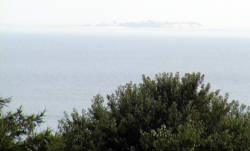
The view to sea
|
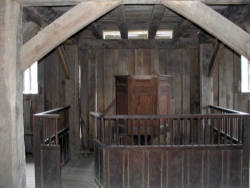
The Fort/Meeting House
|
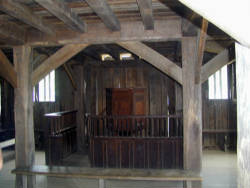
The Fort/Meeting House
|
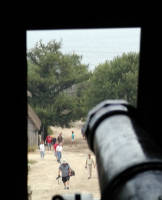
Canon in the Fort/Meeting House
|
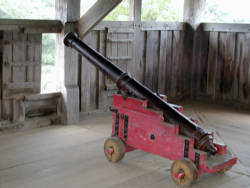
Canon in the Fort/Meeting House
|
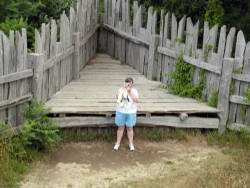
Sue outside the Fort/Meeting House
|
|
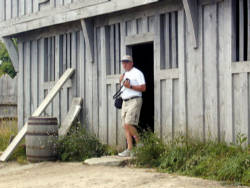
Mike outside the Fort/Meeting House
|
Plimoth Plantation’s Pilgrim Village brings to life the Plymouth of 1627. This year was selected because it is well-documented and represents the village just before the colonists began to disperse beyond the first settlement.
Each house contains painstakingly accurate reproductions of the furniture, tools, and cooking equipment representing the material possessions listed in Plymouth probate inventories. They are not just for display, but are used by the museum staff to re-create the daily life of the colony. The 1627 Plantation was above all a farming community, However, life in Plymouth Colony was not all work and no play. Special times such as births, weddings, militia musters and successful harvests gathered the community for socializing, feasting and even games.
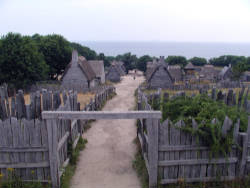
View of the village from the Fort/Meeting House
|
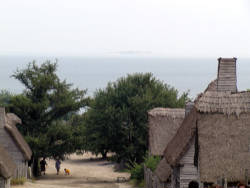
The main street in the village
|
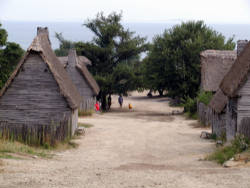
The main street in the village
|

The main street in the village
|
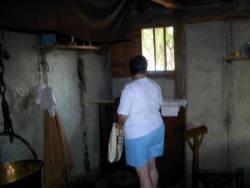
Inside one of the dwellings
|
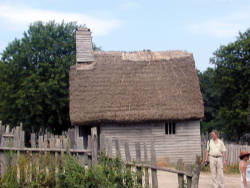
One of the dwellings
|

One of the dwellings
|
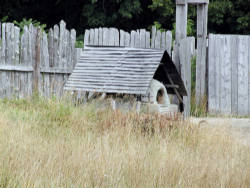
The communal oven
|
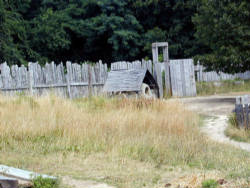
The communal oven
|
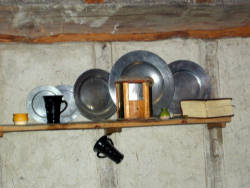
Inside one of the dwellings
|

The hay store
|
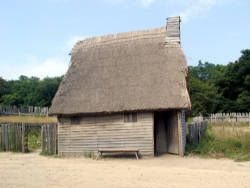
One of the dwellings
|

The communal oven
|
|

One of the dwellings
|
Clothed in period fashions and speaking in the accents of their character’s place of origin, museum staff - "interpreters" - take on the identities of the original inhabitants of the colony. Together, these "first person" roles replicate the social and cultural life of a real human community. The housewife’s primary daily responsibility was feeding and caring for her household. The primary occupation of Plymouth men was farming, although many had training in trades such as coopering or blacksmithing which became part-time occupations.
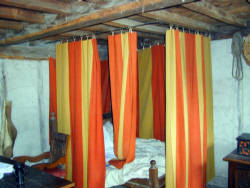
Inside one of the dwellings
|
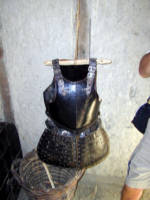
Inside one of the dwellings
|

Inside one of the dwellings
|
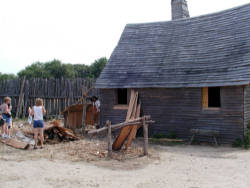
Building the forge
|
The animals are part of a carefully planned and managed program by Plimoth Plantation's Agriculture Department of obtaining and breeding rare and minor breed animals, especially those from 17th-century gene pools. Some of these older breeds of livestock, Kerry and Milking Devon cattle, San Clemente Island goats, Wiltshire Horn sheep, and Tamworth hogs, are classified by the American Livestock Breed Conservancy as having critically low breeding populations.
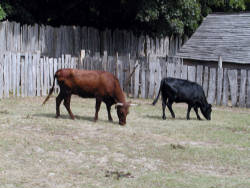
Livestock
|
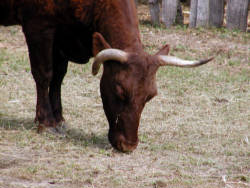
Livestock
|
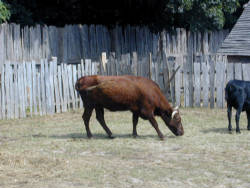
Livestock
|
|
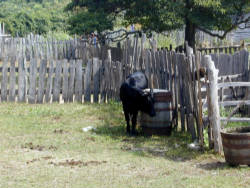
Livestock
|
The Eel River flows just South of the Plantation and broadens into a wide marshy basin below the Pilgrim Village and Hobbamock's Homesite.
For the purposes of the museum exhibit, Eel River "plays the part" of Plymouth's Town Brook, which ran south of the original settlement through salt marshes in 1627.
The river basin was the habitation of Native Peoples for thousands of years before the colonists arrived, and archaeological excavations have found the remains of a Native settlement where Plimoth Plantation's Hobbamock's Homesite exhibit is today. Eel River was at the southerly end of the early Plymouth settlement, and during King Philip's War it was the only place in the Town of Plymouth to suffer hostilities. The Clark garrison house was attacked by an Native raiding party under Totoson and Tispequin on Sunday, March 12, 1675, while the men of the neighborhood were at church. Eleven occupants were killed and the house burned to the ground. The site of William Clark's house was discovered by Harry Hornblower and excavated in 1940 - 42. The bus parking lot west of the Plimoth Plantation Visitor Center covers part of the site today.
In 1750, Eel River's natural outlet into Plymouth Harbor was closed and a new one dug straight into Warren Cove and Massachusetts Bay for the convenience of the farmers who lived along its banks. However, this brought ecological problems as Plymouth Beach began to erode and a storm in 1784 flooded the Eel River basin, killing all of the plant life. The Town voted that year to return the river to its original course. During the 19th century, both Eel River and Town Brook were used to power mills manufacturing iron goods and cloth. Today Eel River provides a scenic natural backdrop to the Plimoth Plantation site, and incidently illustrates the problems of ecological invasions, as Japanese knotweed and phragmites reeds crowd out indigenous plant life along the river side.
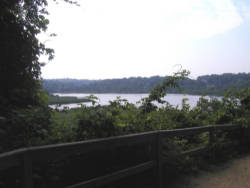
Eel Creek
|
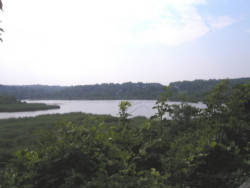
Eel Creek
|
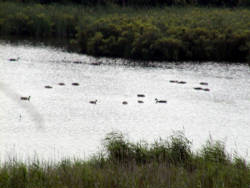
Water Birds on Eel Creek
|
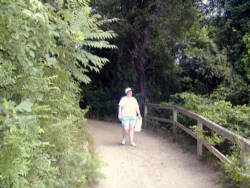
Sue on the nature walk
|
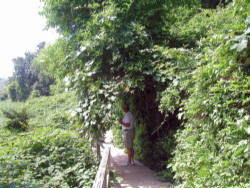
The nature walk
|
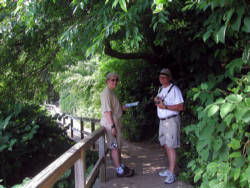
Mike & Chris on the nature walk
|
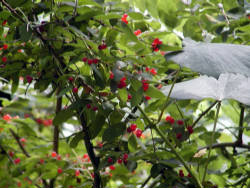
Berries
|
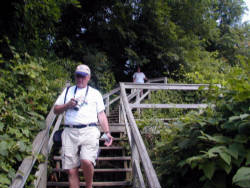
Mike & Sue on the Nature Walk
|
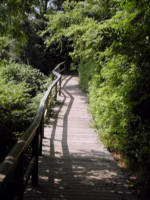
The Boardwalk on the Nature Walk
|
Hobbamock's homesite
Hobbamock, a counselor to Massasoi - the sachem of Pokanoket - came with his family to live in Plymouth in the spring of 1621 after a peace treaty with the colonists.A guide and interpreter for the colonists, he lived on the south side of Town Brook between the fields alloted to the Hopkins and Howland families. Hobbamock lived with the colonists until his death in 1641.
"Only without our pales dwells one Hobbamock, his wives and his household (above ten persons), who is our friend and interpreter. . .
Emmanuel Altham, 1623
Hobbamock, counselor to the sachem Massasoit of Pokanoket (Warren, R.I.) moved to Plymouth with his family as an ambassador from his people. They were the only Wampanaog family known to have lived with the colonists in the 1620s. There were many Wampanoag communities, but none within 15 miles of Plymouth.
The interpreters in Hobbamock's Homesite will speak to you in modern 20th-century English. They will explain what is known about Wampanoag history and culture of the 17th-century and about the many myths and misconceptions about the Wampanoag. Native American staff wear clothing of the period while non-native interpretive guides wear uniforms.
In the Homesite you will see native crops, the types of native housing, food preparation and various demonstrations of traditional skills. Enter the houses, talk with the staff and learn how the latest research improves our knowledge about the indigenous people of this region at the time of the Pilgrims.
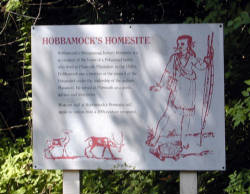
Hobbamock's Homestead
|
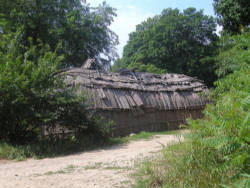
Hobbamock's Homestead
|
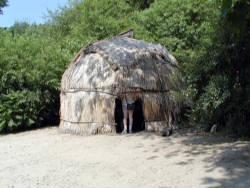
Hobbamock's Homestead
|
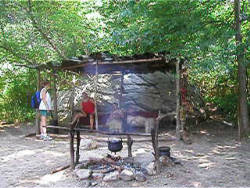
|
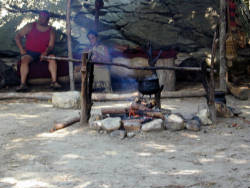
Fire at Hobbamock's Homestead
|
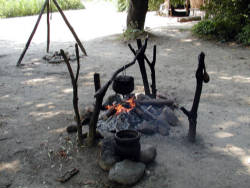
Fire at Hobbamock's Homestead
|
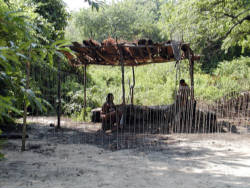
Hobbamock's Homestead
|
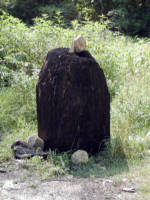
Hobbamock's Homestead
|
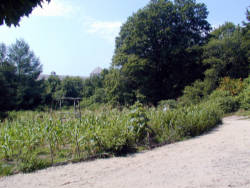
Hobbamock's Homestead
|
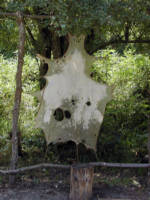
Hobbamock's Homestead
|
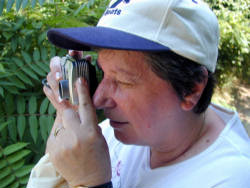
Sue at Hobbamock's Homestead
|
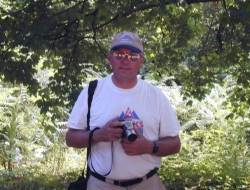
Mike at Hobbamock's Homestead
|
Portland downtown
Portland is the largest city in Maine and is located on a peninsula at the mouth of the Fore River where it flows into Casco Bay.
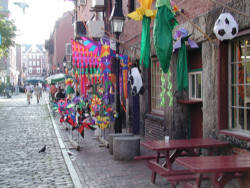
Colourful Kites
|

Boat in Portland Harbor
|
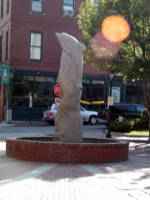
A dolphin statue
|
Portland Head

Kite near Portland Head
|
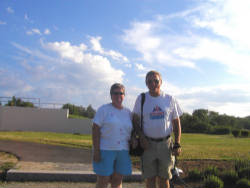
Mike & Sue at Portland Head
|
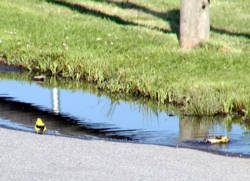
Yellow Bird at Portland Head
|
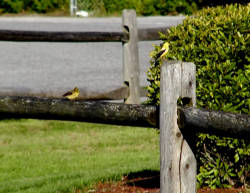
Yellow Bird at Portland Head
|
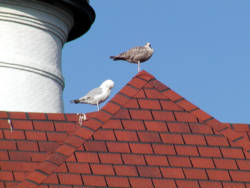
Seagulls at Portland Head
|
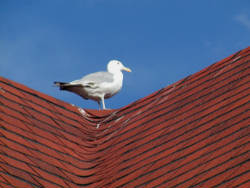
Seagulls at Portland Head
|
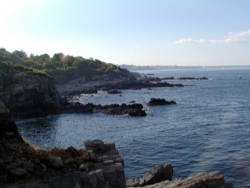
The Coast at Portland Head
|
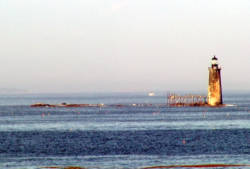
Offshore light-house
|
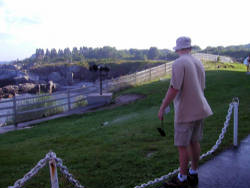
Chris at Portland Head
|

Container ship off Portland Head
|
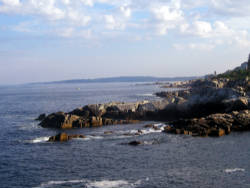
The Coast at Portland Head
|
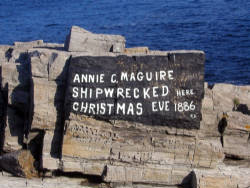
Shipwreck memorial at Portland Head
|

Chris at Portland Head
|
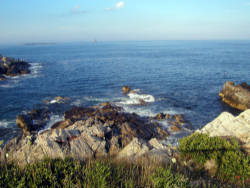
The Coast at Portland Head
|
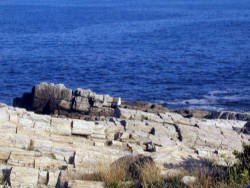
The Coast at Portland Head
|
|

Our rental car
|
Portland Head lighthouse
Portland Head has long protected Portland and the adjacent area. Cape Elizabeth residents were deeply committed to American independence from British rule. In 1776, the new Town of Cape Elizabeth posted a guard of eight soldiers at Portland Head to warn citizens of coming British attacks.
In 1787, the General Court of Massachusetts (the Massachusetts legislature) provided $750 to begin construction of a lighthouse. In 1790, when the United States Government took over the responsibility of all lighthouses, Congress appropriated $1,500 for its completion. The original tower measured 72' from base to lantern deck and was lit with 16 whale oil lamps. It was first lit on January 10, 1791.
Construction of the first Keeper's Quarters began in 1790 as the result of a contract signed by Massachusetts Governor John Hancock. A one story dwelling built to replace the first keeper's house was erected in 1816. It measured 34' x 20' with two rooms, a cellar and a porch in the rear.
By 1864 a 4th order Fresnel lens and a cast iron staircase were installed.
By 1865, the tower was raised 20' and a 2nd order Fresnel lens was installed. A portion of this lens may now be seen at the Museum at Portland Head Light. Except for a period between1883 and1885, this lens was in the lighthouse until 1958.
The current Keepers' Quarters building was constructed in 1891 as a two story duplex. Until 1989, it was home to the head and assistant lighthouse keepers and their families.
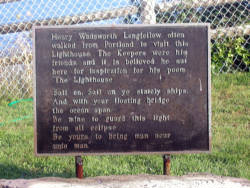
Henry Wadsworth Longfellow plaque
|

Commemorative Bell at Portland Head
|
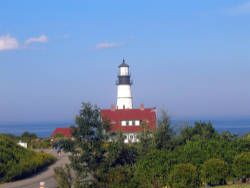
Portland Head Lighthouse
|
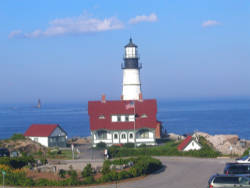
Portland Head Lighthouse
|

Portland Head Lighthouse
|
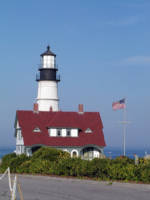
Portland Head Lighthouse
|
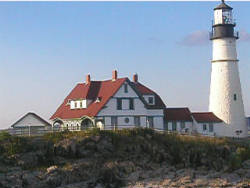
|
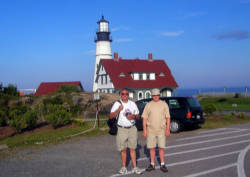
Mike & Chris at Portland Head
|
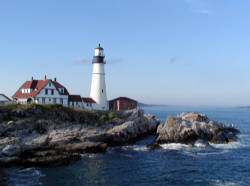
Portland Head Lighthouse
|
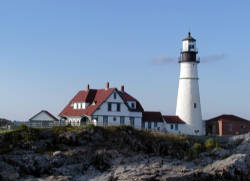
Portland Head Lighthouse
|

Shipwreck memorial at Portland Head
|

Chris at Portland Head
|
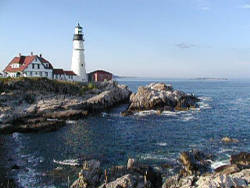
| |
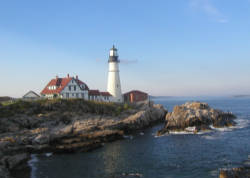
Portland Head Lighthouse
|



















































































































